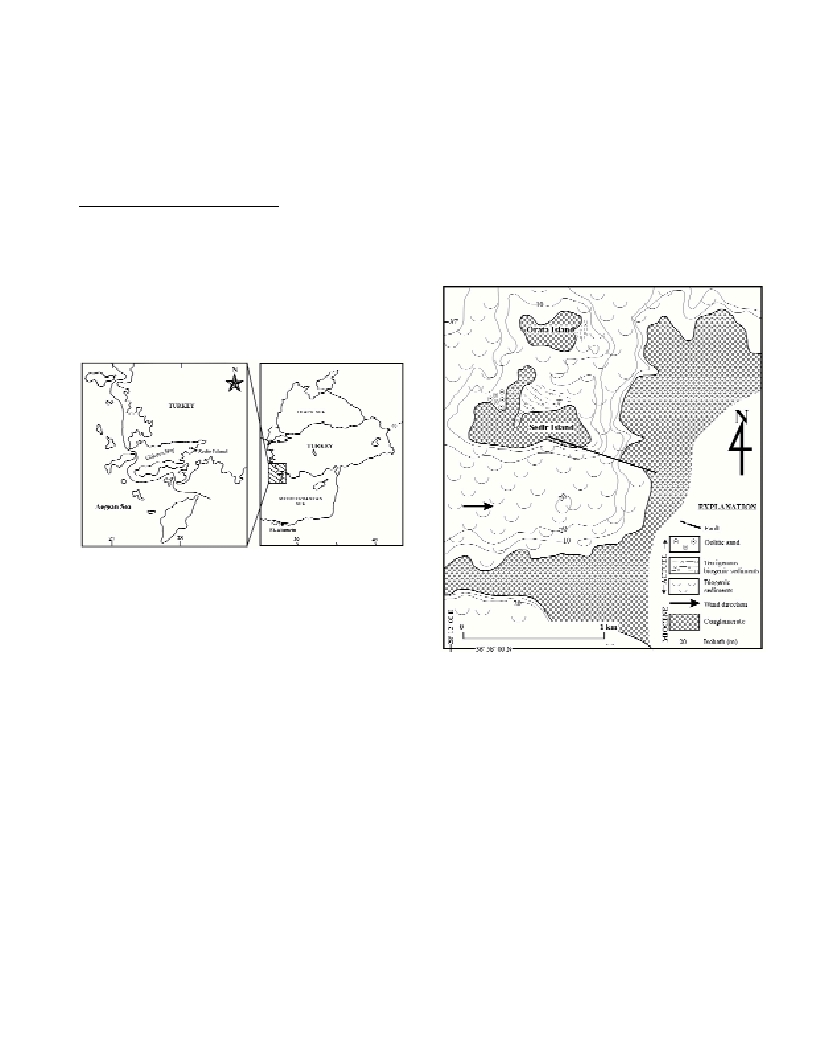ON THE ORIGIN OF THE OOIDS OF THE CLEOPATRA BEACH OF SEDIR ISLAND, AEGEAN SEA, TURKEY
Hüseyin Öztürk
Istanbul University, Department of Geology, Avcilar, 34100, Istanbul, Turkey - ozturkh@istanbul.edu.tr
Abstract
The unique calcitic ooids occur in a very restricted area at Cleopatra Beach at the Sedir Island, along southern coast of Turkey. The cores
of the ooids consist of biogenic matters, such as algae, and rock fragments such as gneiss and granite, while their cortex consist of calcitic
rims. The core materials of the ooids are exogenic and they possibly were brought here from the Egyptian coast, by Marcius Antonius as
the ancient story being told.
Key words: Oolites, Aegean Sea, Turkey
Rapp. Comm. int. Mer Médit., 37,2004
62
Introduction
The unique calcitic ooids that occur in a very restricted area at the
northwest coast of Sedir Island in Gökova Bay (Fig. 1), SW Turkey,
have recently been investigated by several authors with respect to their
inner structure as well as to the conditions of formation (1). On the
other hand, there is an anecdotal history on the origin of the sands of
the Cleopatra Beach that reveals the ooids were brought here by the
Marcus Antonius for his lover Cleopatra from the Egyptian coast,
during the Roman time.
Fig. 1. The ooid formation places on the Sedir Island andthe Egyptian
shore.
Geological setting
The geology of the coastal area lying behind the Sedir Island
consists of silicified carbonates of Cretaceous ages. The rock
associations of the island consist of conglomerates of Pliocene age,
comprise well rounded pebbles of limestone and hematite in
carbonate matrix (2).
The Oolites
The Cleopatra Beach is covered by white-cream colored ooids as
40 m length, 7 m width and average 0.4 m in thickness dimensions.
The ooids are also seen nearly a hundred meters elongation and 0.3 m
average in thick as a fan geometry at bottom of the sea (Fig.2). Joint
or fault-controlled trenches have been detected under the sea in 2m-
7m depth, which lie parallel to the beach. It is interpreted that these
trenches prevent the ooids from going into the sea. The oolites are
scavenged by wave actions from the trenches and carried back to the
beach.
The ooids of the Cleopatra Beach consist of two sectors as core or
nuclides and cortex or rim. The nuclide matter of the oolites is
composed of biogenic matter as nearly being 80 %, and the other
20% are rock fragments. The biogenic matter is composed of clasts
of the algae and small amount of pelecepoda, foraminifera, gastropod
and echinid. The rock fragments as nuclides consist of quartz schist,
gneiss as metamorphic rocks. The granitic and the metamorphic rock
fragments as a nuclide matter are exotic to the rock associations of the
region. Similar rock fragments in nuclides of the ooids have been
reported for the Egyptian shore formations (3).
The petrographic study from the ooids indicates that ooids has been
formed in an area where metamorphic-granitic rocks were cropping
out. Absence of the ooids in the cement material among the stones of
the historical built of the island indicated that the ooids was brought
here during or later than civilization at the island. The presence of a
very local ooid formation at the study area despite similar ecological-
geological conditions such as rock associations, nutrient input,
temperature and salinity of the sea water also support exogenic origin.
Fig. 2. The geology of theSedir Island and location of the ooids.
Acknowledgements. Thanks go to Turkish Marine Research Foun-
dation (TÜDAV) for diving organization during the study.
References
1-Üsenmez S., Varol B., Friedman G.M., and Tekin E., 1993. Modern
ooids of Cleopatra Beach, Southern Aegean Sea, Turkey: Results from
petrography and scanning electron microscopy. Carbonates and
Evaporates, 8: 1-8.
2-Öztürk H., Öztürk B., and Öztürk A. A., 1998. Characteristics and the
formation of the oolites of the Cleopatra Beach, Congress on Underwater
Science and Technology, Istanbul University, pp. 98-104.
3-Boulis S.N., Atia A.K., Hanna K.M., and Marei A.R., 1983. Evaluation
of the oolitic limestone west of the Nile Delta for cement production.
Bulletin of the Faculty of Science,Mansoura University, Faculty of
Science, 10: 283-301.

